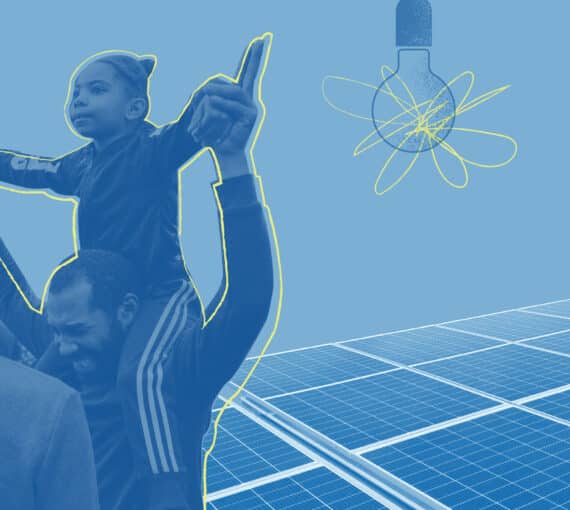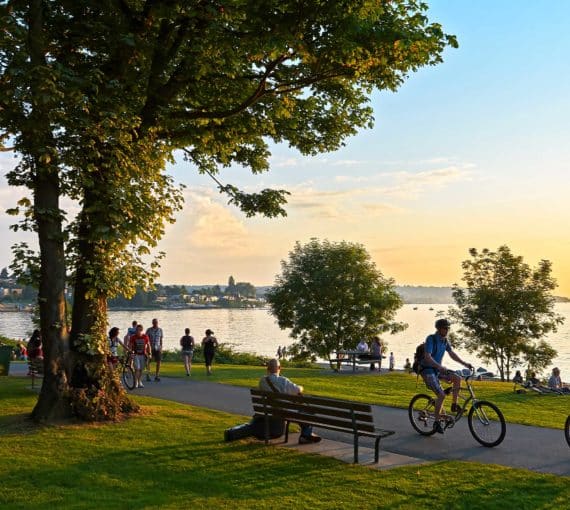
Communities, driven by the desire to develop more equitable, resilient and sustainable places to live are creating new collaborative opportunities for action. (Photo: Hannah Busing via Unsplash)
Communities across Canada have shown that the process of transforming the places we live can come from the bottom up, with much better outcomes. In communities across Canada, residents, civil society organizations, and governments have worked together to envision a better, more sustainable future, write Cameron Esler and Laura Schnurr.
Climate action requires a shift in how we move, produce and consume energy, and design our communities. Transforming our communities to become more sustainable and equitable to live in also requires a shift in determining the actions we take. We need more collaboration between residents and governments, so that residents’ lived experiences inform how we mitigate and adapt to climate change.
We have the opportunity to build a better Canada by listening to residents to let them determine our next steps. By empowering and partnering with communities, the federal government can take important steps toward our climate goals while improving the quality of life for Canadians.
Historically, the approach governments have taken when it comes to creating climate action strategies in Canada has been top down. This needs to change. Communities across Canada have shown that the process of transforming the places we live can come from the bottom up, with much better outcomes.
Historically, the approach governments have taken when it comes to creating climate action strategies in Canada has been top down. This needs to change. Communities across Canada have shown that the process of transforming the places we live can come from the bottom up, with much better outcomes.
Success stories of centering community and residents abound
In communities across Canada, residents, civil society organizations and governments have worked together to envision a better, more sustainable future. These communities provide the blueprint for whole-of-society approaches called for in the National Adaptation Strategy and Canada’s 2030 Agenda National Strategy.
In Regina, youth, environmentalists, refugee and immigrant organizations, women’s groups, business leaders and other community members worked with the city to create an Energy and Sustainability Framework focused on equity and economic opportunity. Together, they dialogued with residents and identified accessible transit as a need for building a better city, but also a climate emission reduction measure.
People united in Edmonton to persuade the city to move forward with a carbon budget, fund a bike network and more. Youth have been particularly active through painting murals, meeting with the mayor and council while also reaching out to community groups. Councillors convened community-based budgeting conversations focused on hyper-local solutions, resilience, social connection and ecological transition. This resulted in multiple incredible neighbourhood projects with strong participation from equity seeking groups.
Communities, driven by the desire to develop more equitable, resilient and sustainable places to live are creating new collaborative opportunities for action.
Meanwhile in Quebec, the Montreal Climate Partnership brings together the city, philanthropic and community organizations, along with local businesses to accelerate decarbonization and strengthen resilience through a whole-of-society approach. At the Montreal Climate Summit held recently, over 900 people from across sectors gathered to advance the work. Low Carbon Cities Canada, ICLEI, Trottier Family Foundation and ECHO Foundation brought 11 cities from across the country to the summit to learn from Montreal’s success with cross-sector collaboration.
In Halifax, a vibrant network of neighbors and concerned citizens mobilized to envision an action plan for a more resilient and healthy future in Atlantic Canada. On June 23rd, 2020, Halifax Regional Council unanimously adopted HalifACT, the regional municipality’s transformational plan to achieve a net-zero economy by 2050. Shortly after, a Climate Action Tax was established in the approved 2022/23 budget to implement the Strategic Initiatives outlined in the plan. The tax is also being used to leverage climate action funding from the private sector, federal and provincial governments, providing the necessary investment for the success of HalifACT in the years to come.
On Salt Spring Island, Transition Salt Spring used the Ethelo platform to reach over 10 per cent of the island’s population in the development of its Climate Action Plan and build consensus among residents with diverse backgrounds, ages and political views.
Town staff in Collingwood, Ontario, are collaborating with an Indigenous working group to re-introduce native plant species into a waterfront park. They are also partnered with local Indigenous communities through the Collingwood Indigenous Circle to connect with the land and one another in ways that advance reconciliation and sustainability.
Lessons for Canada
The examples highlighted above reflect efforts that are occurring throughout Canada. Communities, driven by the desire to develop more equitable, resilient and sustainable places to live are creating new collaborative opportunities for action.
The federal budget invested in climate action; however, by focusing on large corporate actors, it took a step back from the whole-of-Canada approach promoted in its own strategies. The Government of Canada should look to communities and invest in supporting these types of efforts to achieve its climate commitments while advancing the quality of life for all Canadians.
This op-ed was originally published in The Hill Times.
Related projects
Always grounded in sound evidence, the David Suzuki Foundation empowers people to take action in their communities on the environmental challenges we collectively face.



